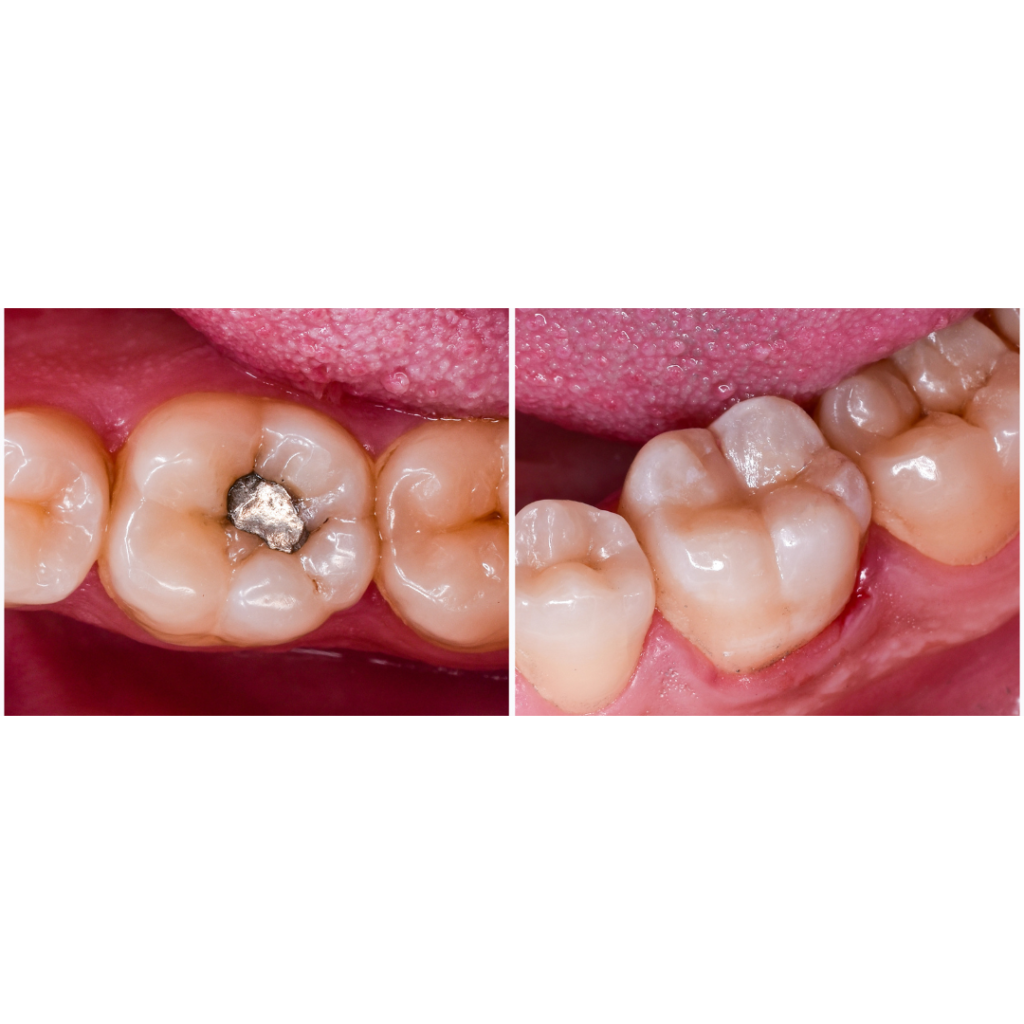Composite Fillings

What are Composite Dental Fillings?
Understanding Modern Tooth Restoration
Introduction
In the sphere of restorative dentistry, composite dental fillings have become increasingly popular. These fillings, known for their aesthetic appeal and durability, are used to repair decayed, chipped, or fractured teeth. This article explores what composite dental fillings are, their benefits, the procedure for their placement, and their care.
Understanding Composite Dental Fillings
Composite dental fillings are made from a mixture of plastic and fine glass particles. They are used to fill cavities caused by tooth decay or to repair damage such as chipped or broken teeth. Unlike traditional amalgam fillings, composite fillings can be closely matched to the color of your natural teeth, making them less noticeable.
Mountain View Pointe Dental's Complete Guide to Composite Fillings
Understanding Composite Dental Fillings: An In-Depth Look
Composite dental fillings, a modern alternative to traditional amalgam fillings, have gained popularity due to their aesthetic and functional benefits. Here’s a detailed exploration of what they are and how they stand out:
Composition and Material
- Material Makeup: Composite fillings are made from a unique blend of plastic resins and finely ground glass-like particles. This composition creates a durable and malleable material that can be easily shaped and polished.
- Quality and Consistency: The quality of composite materials has significantly improved over the years. Modern composites offer enhanced strength and durability, making them suitable for filling cavities in both front and back teeth.
Aesthetic Advantages
- Color Matching: One of the most notable advantages of composite fillings is their aesthetic appeal. The material can be closely matched to the natural color of your teeth, ensuring that the fillings blend seamlessly with your smile.
- Natural Appearance: Unlike metal fillings, composites bond to the tooth structure without leaving dark areas in the mouth, preserving the natural appearance of the tooth.
Application in Dental Restoration
- Versatile Use: Composite fillings are not only used for filling cavities due to decay but also for repairing chipped, cracked, or worn teeth. They are particularly useful in cosmetic improvements of the smile by changing the color or reshaping disfigured teeth.
- Cavity Treatment: In the case of cavities, the composite material is used to fill and seal the cavity, helping to prevent further decay. The flexibility of the material allows for a more conservative approach to tooth preparation, often preserving more of the natural tooth structure.
Comparison with Amalgam Fillings
- Aesthetic Difference: The most significant difference between composite and amalgam fillings is in their appearance. Amalgams are silver and can be quite noticeable, whereas composites are tooth-colored.
- Bonding Capability: Unlike amalgam fillings that simply rest in the prepared cavity, composite fillings bond directly to the tooth structure. This bonding capability provides additional support to the tooth and can help minimize tooth cracking and the need for future dental work.
Durability and Maintenance
- Longevity: While composite fillings are durable, they may not last as long as amalgam fillings in larger restorations subjected to heavy chewing pressure.
- Maintenance: Composite fillings require good oral hygiene practices, including regular brushing and flossing, to maintain their appearance and function. They are also more prone to staining over time compared to amalgam fillings.
Benefits of Composite Fillings: A Comprehensive Analysis
Composite fillings, often chosen for their aesthetic and functional advantages, offer significant benefits in modern dentistry. Here’s a detailed exploration of their key advantages:
1. Aesthetics
- Natural Appearance: The most notable benefit of composite fillings is their aesthetic appeal. They are made to closely resemble the color and texture of natural teeth, making them virtually undetectable in the mouth.
- Custom Color Matching: Dentists can precisely match the shade of composite material to the color of your natural teeth, ensuring a uniform appearance. This is particularly beneficial for fillings in the front teeth or other visible areas.
- Polished Finish: Composite fillings can be polished to a high shine, contributing to a smooth and natural look that blends seamlessly with the tooth’s surface.
2. Bonding to Tooth Structure
- Chemical Bond: Composite fillings chemically bond to the tooth structure, providing a tight, secure fit. This bonding strengthens the tooth by restoring most of its original shape and integrity.
- Reduces Tooth Fracture: This bonding ability can also help to insulate the tooth from excessive temperature variations, reducing the risk of cracks or fractures in the tooth.
3. Versatility
- Multipurpose Use: Besides filling cavities, composite materials are versatile enough to repair chipped, broken, or worn teeth. They can be used for cosmetic improvements, such as changing the shape or color of teeth, and for filling in gaps between teeth.
- Suitable for Different Teeth: Composite fillings can be effectively used in both front and back teeth, accommodating various functional and aesthetic needs.
4. Less Tooth Removal
- Conservative Approach: Unlike amalgam fillings, which often require more extensive tooth preparation and removal of healthy tooth structure, composite fillings typically require less tooth removal. This is due to their ability to bond effectively to the tooth.
- Preserving Natural Tooth: By removing less tooth structure, more of the natural tooth is preserved, which is beneficial for the long-term health and integrity of the tooth.
5. Improved Comfort
- Reduced Sensitivity: The insulating properties of composite fillings can mean reduced sensitivity to hot and cold compared to metal fillings.
- Immediate Hardening: Unlike some other materials that may take time to set fully, composite fillings harden immediately under a special curing light, allowing patients to return to their normal routine more quickly.
The Procedure of Getting a Composite Filling: An In-Depth Look
Composite fillings are a common dental procedure used to restore teeth affected by decay or damage. The process is meticulous and involves several steps to ensure the filling is both functional and aesthetically pleasing. Here’s a detailed breakdown of each stage:
1. Tooth Preparation
- Local Anesthesia: The procedure typically begins with the administration of a local anesthetic to numb the area around the affected tooth. This step is crucial to ensure that the patient is comfortable and pain-free throughout the procedure.
- Removing Decay or Damage: The dentist uses specialized dental tools to carefully remove the decayed or damaged portion of the tooth. This step is important to prevent further decay and to create a clean, healthy base for the filling.
- Cleaning the Tooth: After the decay is removed, the dentist cleans the cavity to eliminate bacteria and debris. This preparation is key to preventing infection and ensuring the filling bonds properly.
2. Applying the Composite Material
- Layered Application: Composite fillings are unique in that they are applied in layers. This technique allows the dentist to precisely shape the filling and adapt it to the natural contours of the tooth.
- Curing Each Layer: After each layer of the composite material is applied, a specialized dental light is used to harden (or cure) it. This light activates a catalyst in the composite, causing it to set quickly.
- Thickness and Strength: The layering process is repeated several times to build up the filling to the desired thickness and strength. The number of layers will depend on the depth and size of the cavity.
3. Shaping and Polishing
- Contouring the Filling: Once the final layer of composite is cured, the dentist shapes the filling to fit the tooth precisely. This involves trimming and smoothing the composite to match the tooth’s natural contours and bite.
- Polishing: The last step involves polishing the filling. This not only improves the appearance, making the filling blend in with the natural tooth, but also smooths out any rough edges, reducing the chance of staining and wear over time.
- Bite Check: The dentist will ask the patient to bite down to ensure that the filling is comfortable and properly aligned. Any final adjustments are made at this point.
Aftercare for Composite Fillings: Ensuring Long-Term Success
After receiving a composite filling, proper aftercare is crucial to ensure its longevity and to maintain overall oral health. Here’s a detailed guide on what to do after getting a composite filling:
1. Managing Sensitivity
- Immediate After-Effects: Post-procedure, it’s common for patients to experience some sensitivity to hot and cold temperatures. This sensitivity is typically due to the response of the tooth to the treatment process.
- Duration: This sensitivity usually subsides within a few days to a week. If it persists or worsens, it’s important to contact your dentist.
- Managing Discomfort: To alleviate sensitivity, you can use toothpaste designed for sensitive teeth. Avoiding extremely hot or cold foods and beverages can also help.
2. Good Oral Hygiene Practices
- Brushing and Flossing: Maintain a regular oral hygiene routine with careful brushing at least twice a day and flossing daily. Use a soft-bristled toothbrush and non-abrasive toothpaste to avoid wearing down the composite material.
- Mouthwash: Incorporating an alcohol-free, fluoride mouthwash can further help in maintaining the health of the tooth and surrounding gums.
3. Dietary Considerations
- Avoiding Hard and Sticky Foods: In the days following your procedure, it’s advisable to avoid very hard or sticky foods. These can put undue pressure on the new filling, potentially dislodging or damaging it.
- Chewing Habits: Try to chew on the opposite side of your mouth from the new filling for the first 24 hours to allow it to set properly.
4. Longevity and Care
- Durability Considerations: While composite fillings are durable and can withstand normal biting pressure, they may be less resistant to heavy chewing forces compared to metal fillings and might need to be replaced more frequently.
- Monitoring Wear and Tear: Keep an eye on your filling for any signs of wear, such as sharp edges, cracks, or pieces chipping off. Regular dental check-ups are crucial for this purpose.
5. Regular Dental Check-Ups
- Routine Visits: Regular dental appointments are important not only for checking the condition of the filling but also for overall dental health. Your dentist can detect any issues early and take necessary action.
- Professional Cleanings: Regular professional cleanings help maintain the health of the filled tooth and the entire mouth, preventing future dental problems.

